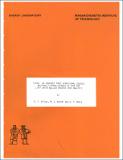TITAN : an advanced three dimensional coupled neutronicthermal-hydraulics code for light water nuclear reactor core analysis
Author(s)
Griggs, D. P.; Kazimi, Mujid S.; Henry, Allan F.
DownloadEL_TR_1984_011.pdf (20.51Mb)
Alternative title
Nuclear reactor core analysis, An advanced three dimensional coupled neutronic/thermal-hydraulics code
Advanced three dimensional coupled neutronic/thermal-hydraulics code
Metadata
Show full item recordAbstract
The accurate analysis of nuclear reactor transients frequently requires that neutronics, thermal-hydraulics and feedback be included. A number of coupled neutronics/thermal-hydraulics codes have been developed for this purpose. Of these, only a few combine three-dimensional neutronics and thermal-hydraulics, and these are either not generally available or too expensive for many applications of interest. Therefore, TITAN, a coupled code combining state-of-the-art three-dimensional neutronics and thermal-hydraulics models, was developed and tested. The three-dimensional nodal neutronics code QUANDRY and the threedimensional two-fluid thermal-hydraulics code THERMIT are combined into TITAN. Steady-state and transient coupling methodologies based upon a tandem structure were devised and implemented. Additional models for nuclear feedback, equilibrium xenon and direct moderator heating were added. TITAN was tested using a boiling water two channel problem and the coupling methodologies were shown to be effective. Simulated turbine trip transients and several control rod withdrawal transients were analyzed with good results. Sensitivity studies indicated that the time-step size can affect transient results significantly. TITAN was also applied to a quarter core PWR problem based on a real reactor geometry. The steady-state results were compared to a solution produced by MEKIN-B and poor agreement between the horizontal power shapes was found. Calculations with various mesh spacings showed that the mesh spacings in the MEKIN-B analysis were too large to produce accurate results with a finite difference method. The TITAN results were shown to be reasonable. A pair of control rod ejection accidents were also analyzed with TITAN. The computing time requirements for these analyses were less than 1 hour c.p.u. time on a large mainframe computer. This is reasonable for a severe transient in a large reactor. A comparison of the TITAN PWR control rod ejection results with results from coupled point kinetics/thermal-hydraulics analyses showed that the point kinetics method used (adiabatic method for contol rod reactivities, steady-state flux shape for core-averaged reactivity feedback) underpredicted the power excursion in one case and overpredicted it in the other. It was therefore concluded that point kinetics methods should be used with caution and that three-dimensional codes like TITAN are superior for analyzing PWR control rod ejection transients.
Date issued
1984Publisher
Cambridge, Mass. : Massachusetts Institute of Technology, Energy Laboratory and Department of Nuclear Engineering, 1984
Series/Report no.
Energy Laboratory report (Massachusetts Institute of Technology. Energy Laboratory) no. MIT-EL 84-011.